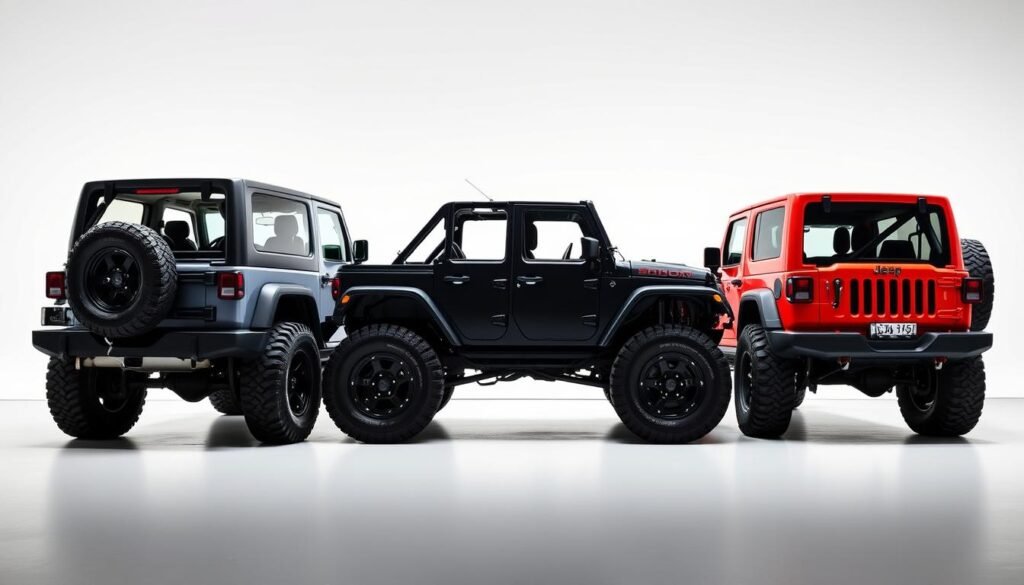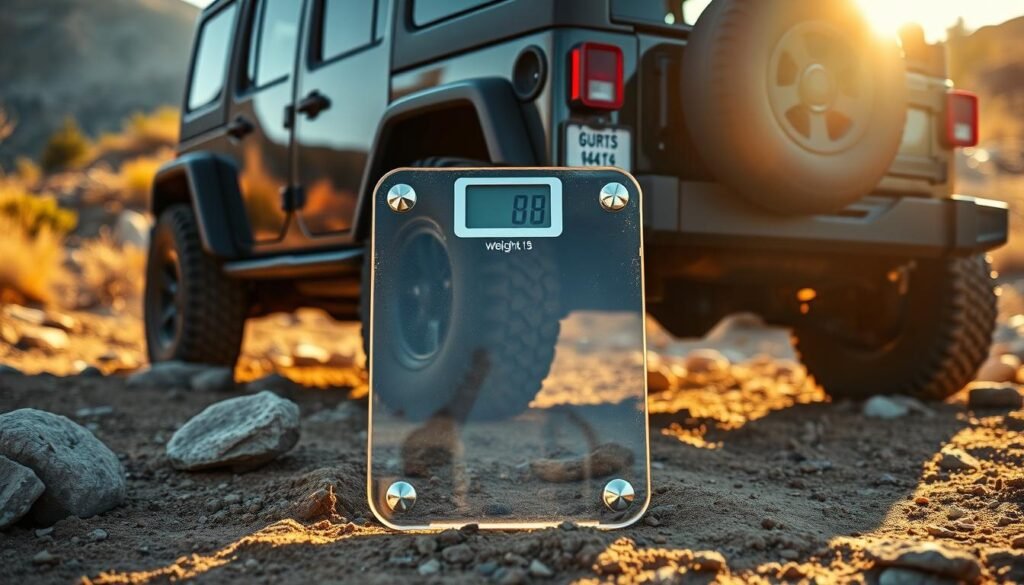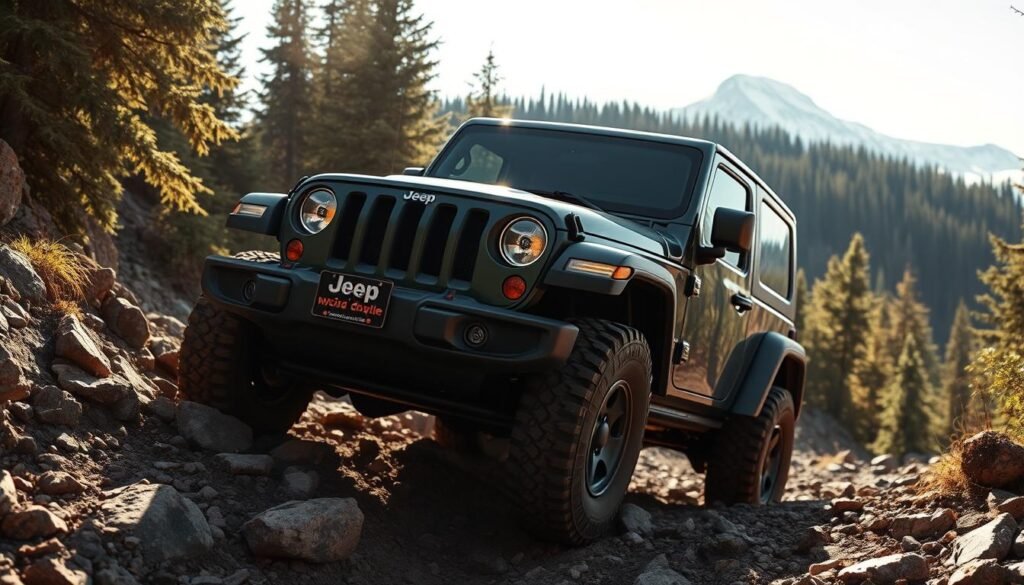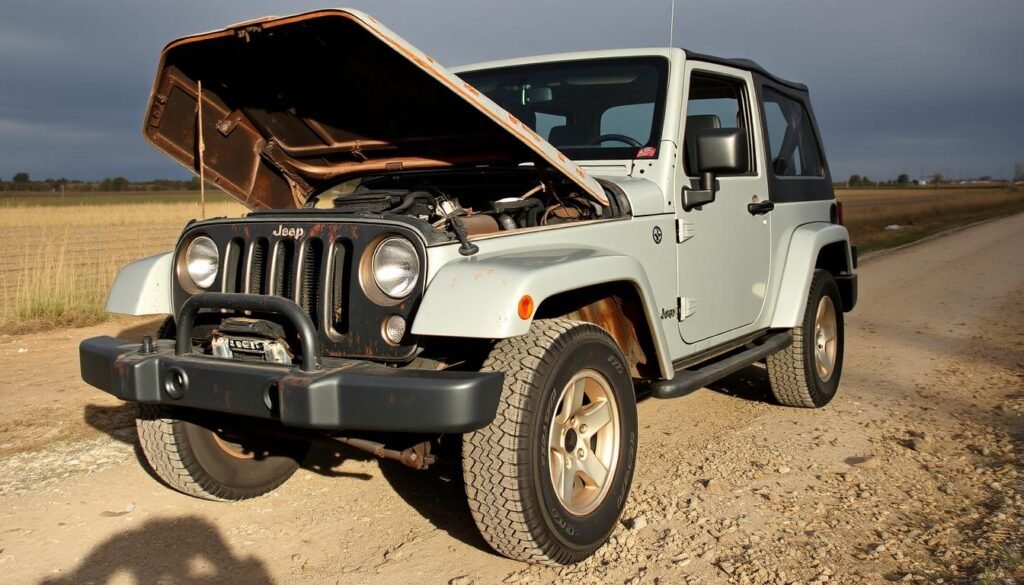“Design is not just what it looks like and feels like. Design is how it works.” – Steve Jobs perfectly captures the essence of understanding a Jeep Wrangler’s weight.
Exploring the Jeep Wrangler’s weight reveals a key aspect of this iconic off-road vehicle. It weighs between 3,970 to 4,500 pounds. This range affects its performance and capabilities.
Understanding the Jeep Wrangler’s weight is more than just numbers. It’s about how weight impacts driving, fuel efficiency, and off-road skills. Each model, from the two-door Sport to the four-door Unlimited, has its own weight.
For those considering a Jeep Wrangler, knowing its weight is essential. Whether for weekend trails or daily driving, knowing the weight helps in making choices about performance and modifications.
This guide will explore the world of Jeep Wrangler weight. We’ll look at everything from base models to fully equipped ones.
Understanding Jeep Wrangler Weight Basics
The weight of a Jeep Wrangler is key to its performance and abilities. Knowing about Jeep Wrangler weight factors helps drivers make smart choices. The weight affects fuel use and how well it handles off-road.
Vehicle weight is more than just a number. It’s about the parts that make up the Wrangler’s total weight. This affects how it drives.
Factors Affecting Wrangler Weight
Several things affect a Jeep Wrangler’s weight:
- Engine type and setup
- Body style (2-door vs. 4-door)
- Trim level and extra features
- Materials used in construction
- Any aftermarket changes
Impact on Performance Dynamics
Weight distribution is vital for a Wrangler’s handling. The right weight balance means better:
- Speed and quickness
- Braking power
- Stability when turning
- Ability to handle rough terrain
“Every pound matters when conquering challenging terrain” – Jeep Engineering Team
Weight Distribution Fundamentals
The Wrangler’s 114.8-inch wheelbase is key to its weight balance. A good balance between the front and back axles means better handling in all driving conditions.
| Weight Factor | Impact |
|---|---|
| Engine Weight | 326-560 lbs (depending on setup) |
| Vehicle Curb Weight | 4,200-5,600 lbs |
| Payload Capacity | 900-1,800 lbs |
Knowing these Jeep Wrangler weight factors helps drivers get the most out of their vehicle in different situations.
Base Weight Range Across Different Models

Knowing the Jeep Wrangler’s weight range is key for buyers and fans. The Wrangler family has different weights that affect how it drives.
The weights of Jeep Wrangler models change a lot. The lightest, the two-door Wrangler Sport, weighs 3,970 pounds. The biggest, the four-door Wrangler Unlimited Sahara, can weigh up to 4,500 pounds.
- Two-Door Wrangler Sport: 3,970 pounds
- Four-Door Wrangler Unlimited Sahara: 4,500 pounds
- Rubicon Model: 4,439 pounds
Weights vary due to body style, trim, and extra features. Buyers should think about these differences when picking their Wrangler.
| Model | Body Style | Curb Weight |
|---|---|---|
| Wrangler Sport | Two-Door | 3,970 lbs |
| Wrangler Unlimited Sahara | Four-Door | 4,500 lbs |
| Wrangler Rubicon | Four-Door | 4,439 lbs |
Adding a hardtop roof can make the Wrangler heavier by about 150 pounds. This is something to consider when choosing a Wrangler.
How Much Does A Jeep Wrangler Weigh
Knowing the weight of a Jeep Wrangler is key for buyers and off-road fans. The weight of a Jeep Wrangler changes a lot depending on the model and setup. It’s important to look at the weight differences.
The Jeep Wrangler weighs between 3,970 to 4,500 pounds. The two-door and four-door models have different weights. These weights affect how the vehicle performs, its fuel use, and its off-road skills.
Two-Door Model Weight Specifications
The two-door Jeep Wrangler is lighter and more compact. It’s great for city driving and navigating tight trails. Here are some key weight details:
- Two-door Wrangler Sport curb weight: 3,970 pounds
- Lighter body design provides enhanced maneuverability
- Ideal for urban driving and tight trail navigation
Four-Door Model Weight Differences
Four-door Wrangler models are heavier because they offer more space and stability. Here are some specific weight details:
- Four-door Wrangler Unlimited Sahara weight: 4,500 pounds
- Approximately 480 pounds heavier than two-door models
- Enhanced stability for off-road and highway driving
Weight Variations by Trim Level
Each Wrangler trim level has its own weight. The Rubicon, made for serious off-roading, shows this:
- Rubicon curb weight: 4,439 pounds
- Additional off-road equipment contributes to increased weight
- Heavier construction supports enhanced trail capabilities
Tip: Adding a hardtop roof can increase overall vehicle weight by approximately 150 pounds, further influencing Jeep Wrangler weight specifications.
Weight Comparison: Sport vs Sahara vs Rubicon
The Jeep Wrangler trim weight comparison shows interesting differences between Sport, Sahara, and Rubicon models. Each trim has unique features that affect the vehicle’s weight and how it performs.

Knowing the weight differences helps Jeep fans choose the right off-road vehicle. Let’s look at the main weight differences in these popular Wrangler trims.
| Trim | Weight | Weight Increase | Performance Impact |
|---|---|---|---|
| Sport | 4,450 lbs | Base Model | Standard Off-Road Capability |
| Sahara | 4,500 lbs | +50 lbs | Enhanced Comfort Features |
| Rubicon | 4,600 lbs | +100 lbs | Advanced Off-Road Equipment |
The weight increases show each trim’s special design. Sahara models add more comfort features. Rubicon trims have strong off-road gear.
- Sport: Lightest trim with standard capabilities
- Sahara: Balanced weight with premium comfort additions
- Rubicon: Heaviest trim with advanced off-road technology
“Every pound matters when conquering challenging terrain” – Jeep Engineering Team
Jeep Wrangler trim weight comparison shows how weight affects performance. Buyers should think about their driving needs when picking between these amazing trims.
Impact of Additional Features on Wrangler Weight
Customizing a Jeep Wrangler can change its weight and how it performs. Knowing how aftermarket modifications affect weight is key for those who want the best off-road experience.

When thinking about adding features to your Jeep Wrangler, remember a few important points. These points help understand the overall weight of your vehicle:
- Hard top installations can add about 150 pounds
- Aftermarket bumpers increase weight by 100-150 pounds
- Larger tire sets contribute 80-100 pounds
- Winch installations add 50-80 pounds
Hard Top vs Soft Top Weight Differences
The choice between a hard top and a soft top affects the Wrangler’s weight. A hardtop is more durable and insulating but heavier. Soft tops are lighter, reducing the vehicle’s weight by 100-150 pounds.
Optional Equipment Weight Considerations
| Modification | Weight Added (lbs) |
|---|---|
| Lift Kit | 50-150 |
| Cargo Rack | 30-80 |
| Heavy-Duty Bumpers | 100-150 |
Aftermarket Modifications Impact
Off-road enthusiasts need to think about each modification’s weight. These changes can alter how your Wrangler handles, affects fuel use, and changes suspension dynamics.
Choosing upgrades wisely helps keep your Jeep performing well. It also meets your off-road needs.
4×4 Systems and Their Weight Contribution
The weight of the Jeep Wrangler’s 4×4 system is key to its performance and off-road skills. Each 4×4 system changes how the Wrangler handles and moves.
Jeep has three main 4×4 systems for the Wrangler. Each has its own weight:
- Command-Trac® 4×4 System: A light part-time system for casual off-road trips
- Rock-Trac® 4×4 System: Built for tough off-roading, with extra weight for strength
- Selec-Trac® 4×4 System: A full-time system with balanced weight
The weight of these systems is about 75-150 pounds. It depends on the model and year. This weight affects how the Wrangler drives, uses fuel, and handles off-road.
| 4×4 System | Approximate Weight | Typical Use |
|---|---|---|
| Command-Trac® | 75-100 lbs | Casual Off-Roading |
| Rock-Trac® | 100-150 lbs | Extreme Terrain |
| Selec-Trac® | 85-125 lbs | All-Terrain Versatility |
Wrangler owners should think about the 4×4 system weight when choosing a drivetrain. It’s a balance between performance, capability, and weight.
Weight Distribution and Off-Road Performance
The Jeep Wrangler shines on off-road trails thanks to its weight balance. Knowing how weight is spread across the vehicle boosts its performance on tough terrain.
Front-to-Rear Weight Balance Dynamics
The Jeep Wrangler usually has a 55/45 front-to-rear weight ratio. This balance is key for good traction and stability on off-road adventures. It affects several important performance areas:
- Enhanced ground clearance
- Improved approach and departure angles
- Better weight transfer during challenging terrain crossings
Trail Performance Impact
The weight of the Jeep Wrangler greatly affects its off-road skills. Lighter two-door models are more agile, while four-door versions are more stable. Every pound matters for the Wrangler’s amazing off-road abilities.
“In off-roading, weight distribution isn’t just a specification—it’s your vehicle’s secret weapon.” – Off-Road Experts
Adding things like aftermarket bumpers or winches can change the Jeep Wrangler’s weight balance. Experienced off-roaders think carefully about these changes to keep the vehicle’s balance and performance top-notch.
Payload Capacity and Towing Capabilities
The Jeep Wrangler is great for adventures and outdoor fun. It has a lot of space for carrying gear and can handle tough terrain. Knowing how much it can carry helps owners use it to its fullest.
- Two-door models max out at 2,000 pounds towing capacity
- Four-door models can tow between 3,500 to 5,000 pounds
- Rubicon models with specific setups can tow up to 5,000 pounds
Each trim level has its own payload capacity:
- Sport, Sport S, and Willys trims: 1,218 pounds
- Sahara trim: 1,228 pounds
- Rubicon and Rubicon X models: 1,327 pounds
Several things affect the Wrangler’s towing power, including:
- Engine type (3.6-liter Pentastar V-6 or 2.0-liter turbo)
- Transmission (automatic vs. manual)
- Specific model and trim configuration
The eight-speed automatic transmission lets you tow up to 5,000 pounds. But, the manual transmission only allows 3,500 pounds. Using the right equipment and setup is key to reaching these max towing limits.
Weight Considerations for Fuel Efficiency
The weight of the Jeep Wrangler is key to its fuel efficiency. Every pound affects how well your vehicle performs and how much gas it uses. Knowing how weight impacts fuel consumption helps owners make better choices for their vehicle.
Lightening your vehicle improves fuel efficiency. Simple changes can help remove extra weight:
- Removing back seat: saves 70 lbs
- Replacing hard top with soft top: reduces weight by over 100 lbs
- Eliminating floor mats: cuts 4 lbs
- Using lightweight aftermarket parts: varies by component
The Jeep Wrangler’s weight varies from 3,970 to 4,500 pounds. Each model has its own fuel efficiency challenges. Two-door models usually have better fuel economy because they are lighter. For example, a two-door Wrangler Sport at 3,970 pounds uses less fuel than the four-door Unlimited Sahara at 4,500 pounds.
Smart weight management can boost your Jeep Wrangler’s fuel efficiency. Look into lightweight upgrades like aluminum spare tire wheels. Also, consider reducing tire size and choosing aftermarket parts that are light.
Pro tip: Every 100 pounds removed can improve fuel economy by approximately 1-2%.
Understanding how Jeep Wrangler weight affects fuel efficiency helps owners make smart choices. They can balance performance, capability, and cost-effective driving.
Weight Management Tips for Wrangler Owners
Understanding how vehicle weight affects performance is key. Reducing your Wrangler’s weight can boost fuel efficiency and handling. Every pound counts in making your vehicle better.
Removing unnecessary accessories and cargo is a smart move. Roof racks, extra spare tires, and heavy add-ons add weight. Opt for lightweight materials like aluminum or carbon fiber to cut down on weight without losing function.
Regular maintenance is vital for keeping your Wrangler light. Check tire pressure and use synthetic oils. Keep your suspension clean to avoid weight gain from dirt and rust.
Choosing the right parts can also help manage your Wrangler’s weight. Aluminum wheels, lightweight bumpers, and compact batteries are great choices. Reducing weight improves performance and efficiency in the long run.
FAQ
How much does a standard Jeep Wrangler weigh?
The weight of a Jeep Wrangler depends on the model and setup. Two-door models weigh between 3,970 and 4,150 pounds. Four-door (Unlimited) models weigh from 4,150 to 4,450 pounds. The exact weight varies based on the trim and added features.
Does the Wrangler’s weight affect its off-road performance?
Yes, the Wrangler’s weight is key for off-road performance. Its weight affects how it handles on rough terrain. Lighter models are more agile, while heavier ones are more stable and can handle bigger off-road challenges.
How do different Wrangler trims impact the vehicle’s weight?
Different trims change the Wrangler’s weight. For example, the Rubicon trim is heavier due to extra off-road gear. The Sport trim is the lightest, and the Sahara is in the middle.
Do aftermarket modifications increase the Jeep Wrangler’s weight?
Most aftermarket parts add weight. Things like bigger wheels, bumpers, and suspension upgrades can add 100 to 500 pounds. This can affect how well the Wrangler performs and its fuel use.
How does the Wrangler’s weight affect fuel efficiency?
The Wrangler’s weight affects its fuel use. Heavier models use more fuel, with mileage ranging from 17-25 miles per gallon. Adding weight from parts or cargo lowers fuel efficiency even more.
What’s the difference in weight between two-door and four-door Wranglers?
Four-door Wranglers are 200-300 pounds heavier than two-door models. A two-door Wrangler weighs 3,970-4,150 pounds. A four-door model weighs 4,150-4,450 pounds, depending on the trim and options.
How do 4×4 systems impact the Wrangler’s overall weight?
Different 4×4 systems add different amounts of weight. The Command-Trac system is lighter. The Rock-Trac system, used in Rubicon models, is heavier due to its complex parts and extra off-road features.
Can I reduce my Jeep Wrangler’s weight?
Yes, you can make your Wrangler lighter. Remove unnecessary accessories and choose lighter parts. Using aluminum and lightweight wheels, and removing extra cargo can help. This can improve performance and fuel use.


